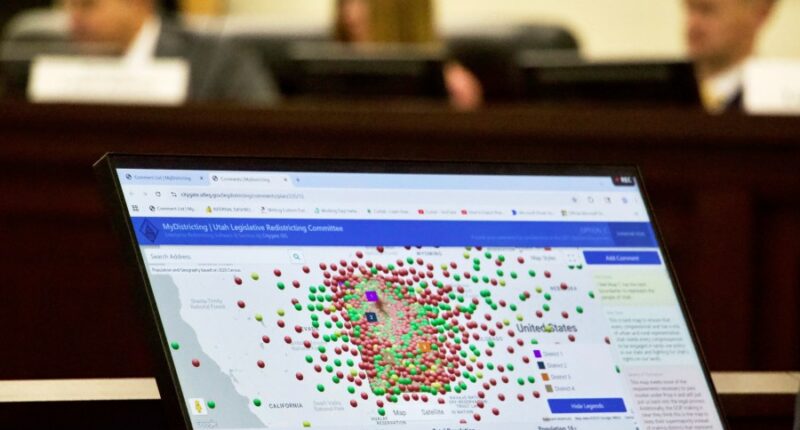Share this @internewscast.com

The Republican-majority Legislature in Utah approved a new congressional map on Monday, which might give Democrats a better chance to gain a seat as they aim to overcome the narrow Republican majority in the U.S. House. However, given the Republican dominance in the state, it’s still unlikely that Democrats will secure a district in the upcoming election.
Republicans currently hold all four of Utah’s House seats.
Following a court mandate, the redrawn map makes two districts slightly more competitive for Democrats, although one is more promising than the other. Despite this, all four districts still have a Republican lean. The revised map now consolidates Salt Lake City into one district extending into rural regions rather than dividing the predominantly Democratic city across several districts.
Experts in redistricting describe this proposal as the least competitive one that lawmakers reviewed, likely providing Republicans their best assurance of retaining their seats. Nonetheless, Democratic National Committee Chair Ken Martin considers it a “prime pickup opportunity.”
The districts still must be reviewed by a judge, who is expected to approve a new map by November.
Earlier in August, Judge Dianna Gibson invalidated the congressional map put in place following the 2020 census since the Legislature bypassed voter-established standards to prevent districts from unfairly favoring a political party, an act known as gerrymandering.
This required map adjustment arrives as former President Donald Trump has encouraged other Republican-led states to engage in redistricting before the midterm elections to gain additional winnable seats for the party.
Utah’s new map introduces an element of uncertainty in a state previously viewed as securely Republican. On a national scale, Democrats need to gain three House seats next year to reclaim control of the chamber from Republicans, who are striving to avoid the historical trend of a president’s party losing seats in midterm elections.
Republican state Sen. Scott Sandall, a co-chair of the Legislature’s redistricting committee, said there are a lot of things they would have done differently if not for the time crunch. Still, he thinks the judge will have no reason to reject the map.
After taking public comment on several proposals, Republicans chose to move forward with the least competitive option. Commenters appeared to favor a proposal from Democrats until the Utah Republican Party sent out an email to rally support for the map now approved by lawmakers.
Democratic state Sen. Nate Blouin was scolded by Republican leaders on the Senate floor when he said he thinks it’s no coincidence that the map most favorable to Republicans was chosen. Sandall insisted the committee did not consider political data.
A handful of Republicans joined Democrats in opposing the map.
During Monday’s special session, Republicans also amended Proposition 4 — a voter-approved ballot initiative from 2018 that sparked the redistricting case — requiring each new district to have a partisan vote share similar to Utah’s recent statewide election results. Republican Gov. Spencer Cox signed it into law later Monday, and the voting rights groups involved in the legal challenge responded with a motion arguing lawmakers were trying “to change the rules of the game.”
Jonathan Cervas, a redistricting expert at Carnegie Mellon University, ran data from past elections in Utah against the redrawn map and found that Democrats would lose every time. That indicates that the map is uncompetitive, he said.
“Although it’s not as competitive as I think the plaintiffs would want, I think it’s far better than the map that currently exists — a stark improvement,” Cervas said.
The map thrown out by Gibson more significantly divided Salt Lake County — Utah’s population center and an island of Democratic support. Before the map was adopted in 2021, one district had traded hands between Democrats and Republicans. All have since elected Republicans by wide margins.
Gibson will now review the map approved by lawmakers and consider alternate proposals from the voting rights groups. If she shoots it down, Cervas anticipates a legal battle over whether the court has authority or an obligation to put in place a map of its own.
If the revised map stands, redistricting analyst Jason Fierman thinks “it’s not insurmountable” for Democrats.
“An extremely strong candidate in a blue wave year might be able to possibly break this cycle of Democrats not winning any of these seats,” said Fierman, who has consulted on maps in other states. Former U.S. Rep. Ben McAdams could be one such candidate, he said. “This could really be a ‘game on’ moment for Democrats, but it would be challenging.”

















